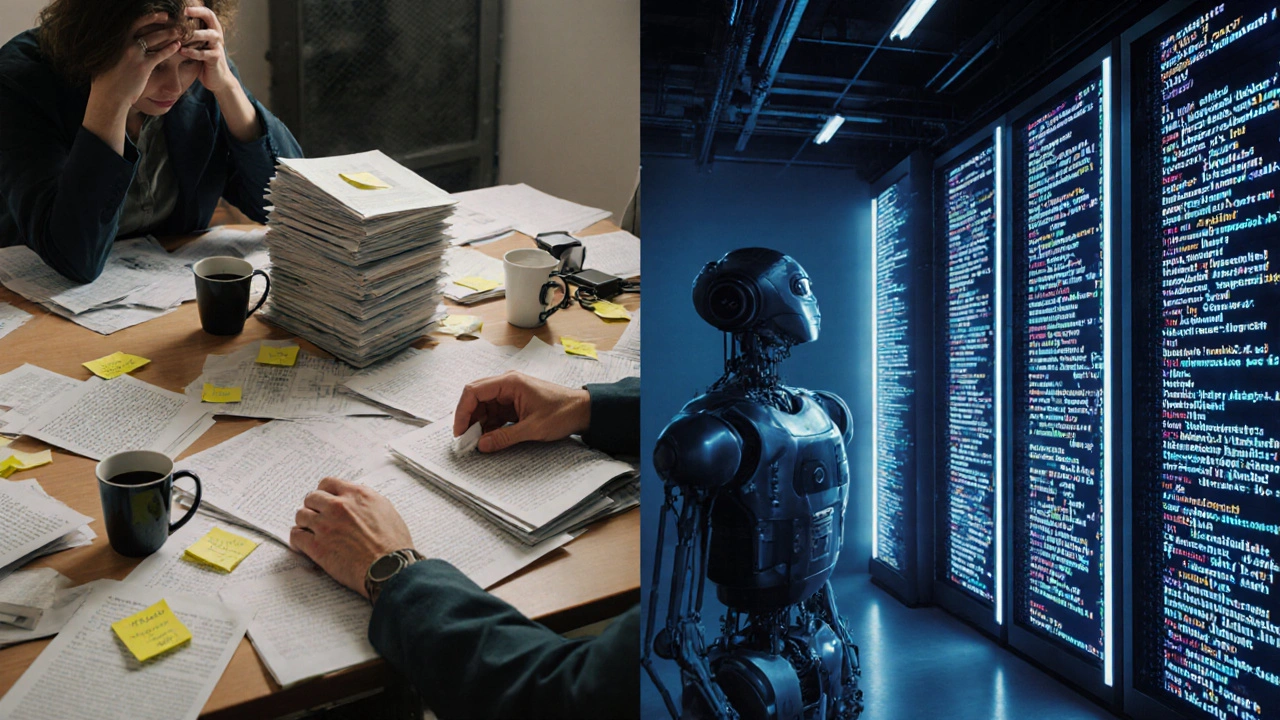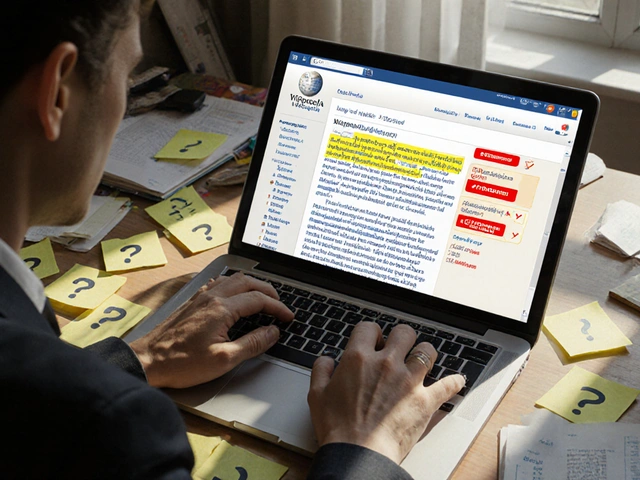
Wikipedia runs on more than just human effort. Behind every clean article, consistent formatting, and timely correction, there’s a quiet team of automated programs-called bots-that handle the heavy lifting. These bots don’t write encyclopedia entries. They don’t decide what’s true or false. But they do the boring, repetitive, and time-consuming jobs that would otherwise drown human editors in paperwork. Without them, Wikipedia would slow to a crawl.
What Wikipedia Bots Actually Do
Wikipedia bots are scripts, usually written in Python or JavaScript, that follow strict rules to perform small, predictable tasks. They don’t think. They don’t judge. They just execute. Think of them as tireless assistants who never get tired, never take breaks, and never complain about doing the same thing 10,000 times a day.
One common bot task is fixing broken links. Every day, thousands of external websites change or disappear. Bots like InternetArchiveBot scan articles for dead links and automatically replace them with archived versions from the Wayback Machine. In 2024 alone, this bot fixed over 20 million dead links across Wikipedia editions.
Another bot, ClueBot NG, watches for vandalism. It scans new edits in real time, comparing them to known patterns of spam, offensive language, or nonsense. When it spots something suspicious, it reverts the edit within seconds-often before a human even notices. ClueBot NG has a 99% accuracy rate, according to Wikimedia’s internal reports, and handles over 90% of all vandalism reverts on the English Wikipedia.
Formatting and Consistency
Wikipedia has hundreds of style guidelines. Capitalization, punctuation, citation formats, template usage-it all adds up. Humans forget. Bots don’t.
Take AutoEd, a bot that fixes spacing, punctuation, and capitalization in article text. It turns “USA” into “U.S.” where needed, adds spaces after periods in lists, and corrects inconsistent use of hyphens and en dashes. These aren’t life-or-death changes, but they make Wikipedia look professional. A reader might not notice the difference-but they’d notice if every article looked messy.
Bots also handle template maintenance. Wikipedia uses templates for infoboxes, navigation bars, and citation styles. When a template changes, hundreds of articles break. Bots like CommonsDelinker or Template:Fix update those articles automatically. Without them, a single template update could require weeks of manual edits by volunteers.
Patrolling and Monitoring
Wikipedia has over 60 million articles. New edits flood in every second. Humans can’t possibly review them all. That’s where bots step in as first responders.
Bot accounts like WP:1.0 scan newly created articles for basic quality issues. They check for minimum length, presence of citations, and whether the topic meets notability guidelines. If an article fails, the bot flags it for human review-or, in some cases, tags it for speedy deletion. This keeps low-quality content from cluttering search results.
Other bots monitor talk pages. They notice when editors leave messages asking for help, request citations, or point out errors. Some bots auto-reply with templates: “Thanks for the suggestion! Here’s a citation template you can use.” Others alert human patrollers when a thread has gone unanswered for 48 hours.

How Bots Are Approved and Controlled
Wikipedia doesn’t let just anyone run a bot. Every bot must be approved by the community. The process starts with a test run on a sandbox page. Then, the bot operator submits a request on the Wikipedia Bot Approvals Group page. Volunteers review the code, test its behavior, and check for edge cases.
Once approved, bots operate under strict limits. They can’t edit more than a certain number of pages per minute. They must include edit summaries that explain what they did. And they’re required to log every action in a public log. If a bot starts making mistakes, humans can disable it in minutes.
Some bots are even designed to pause themselves. If a bot detects an unusual spike in edits-say, a sudden flood of edits to a trending topic-it will stop working until a human confirms it’s safe to continue.
Why Humans Still Matter
Bots aren’t replacing editors. They’re freeing them up. Think of bots as the janitors and clerks. Humans are the curators, researchers, and writers.
For example, a bot might fix a broken link in a biography of a scientist. But only a human can determine whether the scientist is notable enough to have an article in the first place. A bot can format a citation correctly. But only a human can judge whether the source is reliable or biased.
Wikipedia’s most important decisions-what to include, what to remove, how to handle disputes-are still made by people. Bots just make sure the house is clean while the humans do the hard thinking.
Real Examples of Bot Impact
Take the Anti-vandalism bots on the English Wikipedia. In 2023, they reverted over 2.5 million edits. That’s roughly 7,000 per day. Without them, human patrollers would be overwhelmed. Many editors say they wouldn’t contribute at all if bots didn’t handle the noise.
On the French Wikipedia, the bot AnomieBOT automatically adds categories to articles based on their content. It reads the text, identifies key terms, and assigns the right category-like “20th-century American novelists” or “Climate change in Europe.” This makes articles easier to find and improves the site’s internal linking structure.
Even small bots make a difference. One bot, DeadlinkBot, checks every new article for at least one working citation. If none exists, it leaves a friendly message: “This article needs a source. Here’s a link to help you find one.” It doesn’t edit the article-it just nudges editors in the right direction.

What Happens When Bots Go Wrong
Bots aren’t perfect. Sometimes they make mistakes.
In 2017, a bot on the German Wikipedia started replacing the word “feminist” with “womanist” in thousands of articles. It didn’t understand context-it just swapped synonyms. Within hours, hundreds of articles were altered incorrectly. A human noticed, rolled back the edits, and disabled the bot.
Another time, a bot on the English Wikipedia tried to “improve” article titles by removing accents from names like “José” and “François.” It didn’t realize that those accents are part of proper names. The fix was reverted, and the bot’s code was updated to respect Unicode characters.
These incidents show why oversight matters. Bots are tools, not authorities. They follow rules-but humans set the rules. And humans always have the final say.
How You Can Use Bots Too
Even if you’re not a programmer, you can still benefit from bots. If you notice a pattern-like the same formatting error appearing across dozens of articles-you can suggest a bot fix to the Wikipedia community. Many bot operators welcome ideas from editors.
There’s also a growing list of semi-automated tools that help humans edit faster. Tools like QuickStatements let you bulk-edit Wikidata entries. ClueBot NG’s user interface lets you report vandalism with one click. These tools are built on the same bot infrastructure, but they’re designed for human control.
Wikipedia’s success isn’t because it’s perfect. It’s because it uses automation wisely. Bots handle the routine. Humans handle the meaning.
Do Wikipedia bots write articles?
No, Wikipedia bots do not write articles. They only perform repetitive maintenance tasks like fixing links, reverting vandalism, and correcting formatting. Writing articles requires judgment, context, and research-things bots can’t do. Only human editors create and expand content.
How do I know if an edit was made by a bot?
Bot edits are clearly labeled. The username will end in “bot,” like “InternetArchiveBot” or “ClueBot NG.” In the edit summary, bots usually include phrases like “Fixing dead links” or “Reverting vandalism.” You can also check the edit history-bot edits are often grouped and tagged with a small robot icon.
Can I create my own Wikipedia bot?
Yes, but you need approval. You must write a clear proposal, test your bot on a sandbox, and submit it to the Bot Approvals Group. Your bot must follow Wikipedia’s rules, have a low edit rate, and include a way for humans to override it. Most approved bots are used for small, well-defined tasks-not large-scale changes.
Are bots faster than humans at editing?
Yes, by a huge margin. A bot can fix 1,000 broken links in under an hour. A human might take a week to do the same. Bots don’t get tired, don’t need sleep, and don’t miss repetitive tasks. But they can’t understand nuance, bias, or context-that’s why humans still run Wikipedia.
What happens if a bot makes a mistake?
If a bot makes a mistake, any editor can revert the edit immediately. Bot operators are required to monitor their bots and respond quickly to complaints. In serious cases, the bot can be blocked by administrators. Most mistakes are caught within minutes because bot edits are public and easy to track.
Next Steps for Editors
If you’re a Wikipedia editor, start by learning how to spot bot edits. Look for the “bot” tag and read the edit summaries. You’ll quickly see how much work they do behind the scenes.
Next, consider contributing to bot development. You don’t need to code. You can suggest tasks: “Wouldn’t it help if a bot checked for missing categories in biographies?” Many bot operators listen to editor feedback.
Finally, appreciate the quiet work of bots. They’re not glamorous. But without them, Wikipedia wouldn’t be the reliable, clean, and consistent resource it is today.






